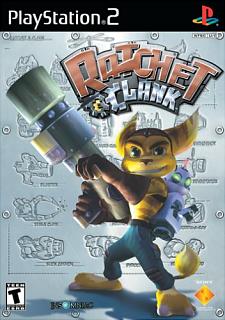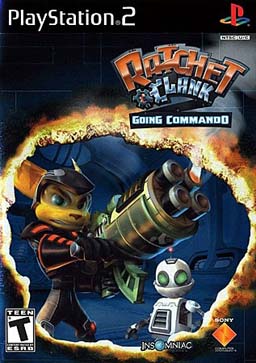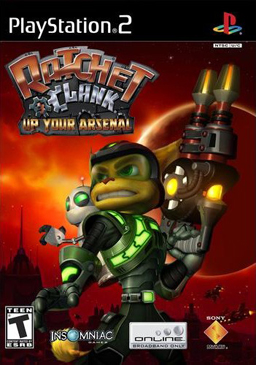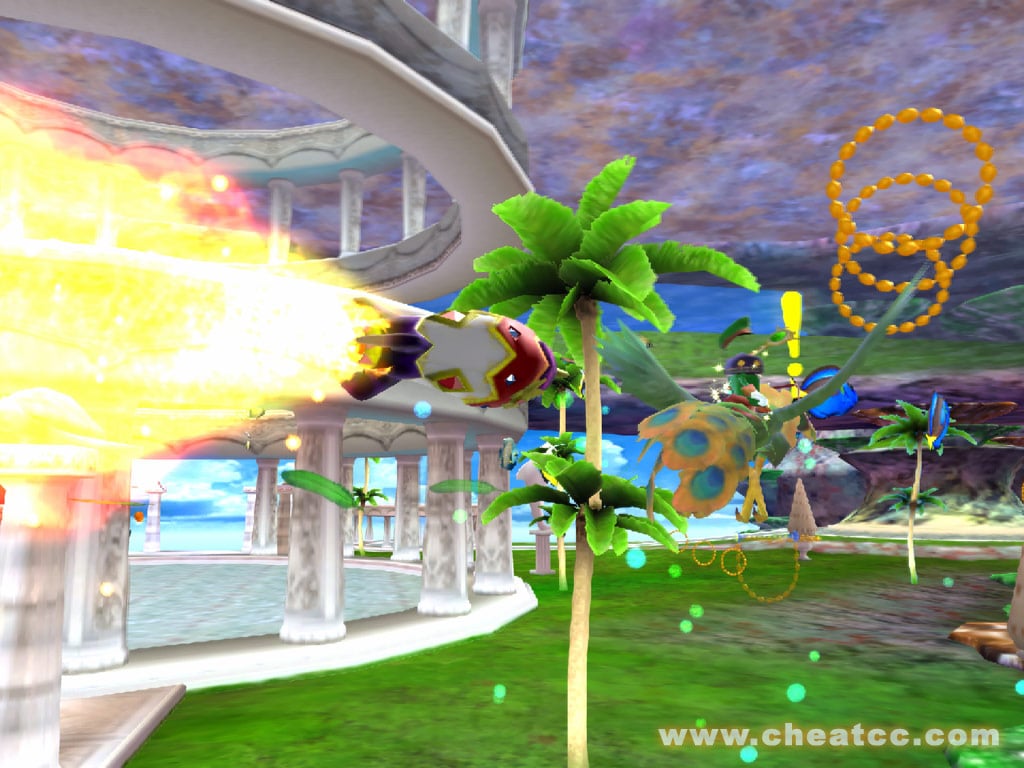Come one, come all, for it is that time of year once again.
2012 is the tenth anniversary of yet another prolific series that started on
the PlayStation 2: namely, a quaint little platforming franchise by the name of
“Ratchet & Clank”. One of the PS2’s mascots back in the 2000’s alongside
the likes of Jak and Sly Cooper, Ratchet & Clank seamlessly combined the
elements of a typical platformer with a third-person shooter, something that
was expanded upon by later installments that have gone on well into the PS3
era. Fortunately, unlike former mascot Spyro the Dragon, the series has
remained under the control of the original developer and thus has yet to
devolve into a hollow, despicable shell of its former self. That is, unless you
hated All 4 One just that much. Anyway, in honor of this occasion, I will be reviewing the original trilogy
for the PlayStation 2. I was going to review the entire series like I did with Kingdom Hearts, but unfortunately, I soon found I was too preoccupied with other games and such to do so. Nonetheless, off we go.
 |
| Ratchet & Clank |
Ratchet & Clank introduces us to our two titular
protagonists: Ratchet, an alien being known as a Lombax; and Clank, a tiny
robot. After being born on an assembly
line due to a glitch, Clank finds a recording on an Infobot that tells the
plight of the “Blargs”, led by Supreme Executive Chairman Drek. As it turns out, their home planet has become
much too polluted to support life, and so they intend to create a new planet
using the pieces of other planets, which will inevitably lead to said other
planets’ destruction. Clank escapes, but after an epic space battle, he is sent
crashing down to the surface of the Planet Veldin, where he meets Ratchet, who
is currently working on a spaceship. Clank, as luck would have it, has the
parts necessary to make the spaceship run, and Ratchet agrees to help Clank if
he would be so kind as to provide them. Thus begins an adventure of epic
proportions.
The storyline of Ratchet & Clank…really isn’t much to
write home about. It’s mildly interesting and gets points for some solid
writing, which leads to a number of funny lines and moments, as well as some
stellar voice acting. However, there are some pretty big problems holding it
back. In particular, those two problems would be the main protagonist and the
main villain. Clank is a decent enough character and Ratchet comes off as okay
at first, but after a big moment in the plot, he immediately becomes a total
jerk to his adventuring buddy and generally starts to come off as quite
selfish, wanting to chase after a secondary villain while the main one is
basically committing mass homicide. This could
have been handled well if it hadn’t been emphasized too much, but for the next
few hours of the game, it’s like it becomes his main character trait. Of
course, once the secondary villain is defeated, he apologizes and snaps back to
his old self just as quickly and is ready to once again take on Drek. Bottom
line, he’s far from a likable protagonist, just as Drek is far from an
interesting villain. He has some funny lines here and there, but in the end
comes off as very clichéd, especially at the game’s end.
But anyone playing a platformer for the story should
probably reevaluate their lives. Of course, Ratchet & Clank is more than just a platformer. As already stated, Ratchet
& Clank opted to seamlessly blend platforming and shooting, as did its
eventual sequels. Did the mix work? I suppose it should go without saying at
this point that the answer is a resounding “yes”. Over the course of the game,
you will gain a variety of weapons, which, while considerably “tamer” than the
toys later installments would give us to play with, are quite a bit of fun to
use. Especially notable are the Pyrocitor, a flamethrower; the Devastator, a
rocket launcher; and my personal favorite, the Visibomb Gun, a
remote-controlled missile launcher. Oh, and Ratchet also has a giant freaking
wrench that he uses to smack people around with. But even the most fun of
weapons can’t help a game much when there aren’t any challenging enemies to use
them on, and I’ll admit, when the game starts out, it will seem pretty lacking
in this department. The enemies will come off as ludicrously easy in the
opening areas, but things quickly pick up once you get to Nebula G34 and the
difficulty steadily increases from there, to the point of becoming quite tough
towards the end.
As for the platforming, equally emphasized as the game’s
weapons are “gadgets”, which are various little utilities you collect over the
course of the game that help you to overcome the obstacles and puzzles that
stand in your way. There are quite a few of these, but the most notable ones
are Clank’s upgrades, which include such accessories as the Heli-Pack, Hydro
Pack, and even a Jet Pack. Each of these, aside from being incredibly cool,
helps to meaningfully improve Ratchet’s mobility by allowing him to cross
larger gaps, do ground pounds, swim faster, or what have you. There are also
the Grind Boots and Gravity Boots, which allow you to grind on rails and walk
on special walls and ceilings (respectively), as well as the Swingshot
(basically a glorified grappling hook), and the Hydrodisplacer, which allows
you to empty and fill certain bodies of water, along with many others. Much
like the shooting aspect, platforming starts out fairly simplistic and easy,
but as more and more of these gadgets become available to you, the level
designs grow significantly in complexity and challenge level. What’s also
interesting is that, while each planet is technically linear in design, they
still contain different objectives for you to complete and give you a bit of
freedom as to your approach thereof. The design thus ends up being very solid
overall, but Ratchet & Clank also gives you a very satisfying sense of
progression as you collect more weapons and upgrades, something that not too
many platformers have to offer.
What’s almost as impressive as the gameplay is Ratchet & Clank’s presentation. Obviously, the game doesn’t look as stunning as it did ten years ago, but it still holds up surprisingly well, especially in terms of animations. They’re incredibly fluid, both during gameplay and in cutscenes, and one tiny thing that I always thought was amazing was the fact that Ratchet actually points all weapons upward if you approach a wall. This is something not even a lot of first-person shooters do even today. Sure, it’s a little thing, but back then, it was always a surprise to see that kind of attention to detail. The weapons themselves all have different animations upon being summoned as well as accompanying sound effects thereof, and the environments really don’t look half-bad either. There’s one moment in an area late in the game where you’re basically walking upside down on a giant space ship carrying a half-finished planetary body with another nearby planet visible off in the distance, and I swear, it still accomplishes that feeling of “Holy crap, I am walking upside down on a giant space ship carrying a half-finished planetary body with another planet visible off in the distance”. On a technical level, this game was pretty ahead of its time. On top of that, each location just feels alive in its own way. As already noted, each planet contains several different areas to visit. There is a different soundtrack and atmosphere for each, and the enemies you encounter on every planet only add to this feeling. A planet often used as a logging site, for instance, sees you going up against lumberjack robots and buzz saw-wielding enemies, and a planet in the throes of war pits you against soldiers, tanks and battleships. Enemies are rarely rehashed for other locations and when they are, they feel like they belong.
Worth noting is that there are a few areas in the game that
are played with Clank alone. His move set is very limited when compared to
Ratchet’s and he’s not a very good fighter either, but what makes these
segments interesting is that you can take control of “Gadgebots”. Aside from
attacking enemies for you, these are also necessary for solving puzzles, and
the fact that you have to keep them alive also creates an interesting
challenge. Clank’s sections are nothing spectacular, but are pretty neat in
their own right.
 |
| I couldn't find any other good screenshots of the first game, so instead enjoy these two adorable puppies. |
In short, Ratchet & Clank, while far from the series’
best, was excellent for its time and is still a quite worthy title today. It
does feel pretty dated after playing the later games, but that’s really not its
fault. Speaking of which…
 |
| Going Commando |
Ah, Going Commando. This is the game that started the
endearing little title running gag. Anyway, in Going Commando, Ratchet &
Clank are suddenly transported to the Bogon Galaxy, where a company known as
Megacorp has a monopoly on all commerce. They had been called there by CEO Ambercrombie
Fizzwidget, who informs them that an experiment had been stolen by a mysterious
thief and then hires them to stop said thief. Then the plot thickens, crap hits
the fan and lots of stuff happens. The storyline, while still nothing really
special, is quite a bit more interesting than the first game’s. Ratchet also
gets a much-needed characterization overhaul that makes him a far more likable
character, complete with a voice change. He is now Tidus from Final Fantasy X.
Haw haw haw. All that aside, the writing is even funnier this time around and
the plot twist at the end regarding the villain does a lot to add to the story
as well. In short, it’s pretty nice.
But the story isn’t the only thing you can expect to have
improved in Going Commando. In fact, I’m going to say this right now: Going
Commando is an almost perfect sequel.
Not just to the original Ratchet & Clank, but period. It’s a paragon of how
to build on to an already solid experience. As for why, let’s start with the
game’s weapons. Not only is the selection far larger than it was in the
original, but it’s simply cooler. The
original Ratchet & Clank’s arsenal is utterly bland by comparison. Gone are
the simple flamethrowers, bomb gloves and the like. Instead, Going Commando
gives us such firepower as the electrified Plasma Coil, which can damage
several enemies at once; the Synthenoids, robotic buddies that come to your
aid; the Seeker Gun, which shoots out missiles that home in on targets once
they pass by; the Bouncer, which explodes into tiny, destructive grenades on
impact, and many more.
But the coolest thing actually isn’t the weapons themselves
so much as the fact that you can actually upgrade them this time around, a
feature would take even more prominence in later installments. The more you use
a weapon, the more EXP it gains, and it eventually transforms into something
even more awesome. An early weapon, the Gravity Bomb launcher, for instance,
transforms into the Mini-Nuke launcher, which actually remains quite useful
throughout the game’s entire duration. The Minirocket Tube becomes the
Megarocket Cannon, which allows for charged shots, and so on and so forth. RPG
elements also come into play in regards to upgrading Ratchet’s health in this
game, as the more enemies you kill, the more EXP you gain, which eventually
leads to health upgrades. This not only adds an incredible amount of depth to
the gameplay, but it’s also necessary to make use of this, as the difficulty
becomes quite brutal as the game goes on. And unlike the first game, Going
Commando doesn’t pull too many punches for new players; it’s reasonably
challenging from the get-go. Of course, the game remains fair throughout its
duration, so it comes off as more of a fun challenge than a frustrating one.
Just be prepared.
The platformer side of the game has been expanded upon
brilliantly as well. The game does focus a bit more on puzzle solving than the
first game, but the straight-up platforming this game offers is still very
strong. In general, the amount of creativity that has gone into the game’s
various challenges is really quite astounding, and there are some nice new
gadgets to go along with them. Particularly noteworthy are the Dynamo and
Tractor Beam, the latter of which powers up or creates objects briefly and the
former of which allows you to maneuver certain objects. And while it doesn’t
have much to do with actual platforming, the game also gives you Glider and
Levitator gadgets, both of which lead to some very fun and challenging flying
sections. But even that isn’t all this game has to offer. Over the course of
this game, you will play through space dogfighting levels, a fun racing
mini-game, and, in what would become a series staple, fighting tournaments.
Most missions involving these are optional, but they are very nice and are yet
another excellent example of how much more this game has to offer than the first game.
Even Clank’s few solo areas have been expanded on a bit. Not only are they
generally more interesting in design, but they give you more robots to control,
such as the Bridge Bot and Hammer Bot, that have different uses.
Going Commando has equivalents to the Trespasser of old, but
they’re much more fun to use. These gadgets would be the Electrolyzer and
Infiltrator. The Electrolyzer requires you to manipulate connectors with the
press of the “X” button in order for an electrical charge to enter each, and
the Infiltrator puzzles ask you to move an electrical charge along sections of
a sphere, wrapping around it until it makes it back to the start. Both types of
puzzles are actually pretty enjoyable and are much less annoying and
pace-breaking than the Trespasser puzzles. The one problem I do have with Going
Commando is with the sections played as Giant Clank. There were a couple of short
ones in the first, and they were alright, but here they just come off as
repetitive and dull. You have a few more weapons at your disposal, but they’re
not incredibly useful against the bosses thereof. Not only that, but they tend
to drag on for quite a while. There are only two of these areas in the entire
game, but they’re pretty dang annoying. That aside, Going Commando is a gaming masterpiece and
easily one of the best platformers of the PS2 era. As for the next game…
 |
| Up Your Arsenal |
The third game in the series and last of the original
trilogy, Up Your Arsenal at first sees Ratchet & Clank going up against an
alien race known as the “Tyhrranoids” alongside a cowardly group of soldiers. It
turns out that the mastermind behind this is Dr. Nefarious, aided by his
ever-faithful butler, Lawrence. His evil
plan is to rid the galaxy of all organic life forms. Naturally, that doesn’t
fly, but it turns out that the only one who was ever able to defeat Dr.
Nefarious was Captain Qwark, who has mysteriously disappeared. Ratchet &
Clank find him…under strange circumstances, but once Qwark has his memory back,
he organizes a group called the “Q-Force” that will go up against Nefarious’
forces. Thus begins yet another adventure of epic proportions.
The storyline of Up Your Arsenal is actually quite
enjoyable. Not only is the writing even better than in the previous two games,
but the villain, Dr. Nefarious, is pretty awesome. I’ve not seen many villains
as intentionally hammy as this guy. He makes Ghirahim from Skyward Sword seem
subtle. Lawrence is pretty funny, too, specifically thanks to his attitude
about his job and the guy he happens to be working under. Most of the other
characters are very enjoyable as well, and, in comparison to the previous
games, the general plot is pretty interesting. Overall, Up Your Arsenal
definitely has the best storyline of the PS2 trilogy.
In terms of gameplay, though, what can you expect? Well, I
suppose I should say right now that Up Your Arsenal’s level designs are pretty
bland in comparison to the first game’s and Going Commando’s. The platforming
is still there, but in much smaller amounts, and while there are some pretty
nice areas here and there - Annihilation Nation’s deathcourses, in particular -
most of it isn’t terribly interesting. Even the puzzles, what few there are,
aren’t anything to write home about either. Most of the time, they just consist
of you using the Refractor gadget to redirect lasers, which holds very little
challenge and doesn’t require much thought. Most of the new gadgets aren’t
anything too remarkable either; the Hypershot is simply a combination of the
Swingshot and Dynamo without any of the interesting platforming and puzzle
segments that went along with the latter and the creatively-named Hacker leads
to this game’s door-hacking mini-games, which aren’t really anything special.
You simply collect green blobs and shoot the red ones; there’s really not much of
a challenge to it. The only really interesting new gadget is the Tyhrra-Guise,
which turns you into a Tyhrranoid. You will need to make use of this to get
past certain doors and barriers, and I have to say, I think it’s pretty
creative how conversations with other Tyhrranoids are played as a rhythm game.
Most of Up Your Arsenal’s levels are more explicitly linear than those of the
previous two games, as well, only having one path that you stick to the entire
time rather than having two or three different paths that take you to different
objectives. However, this was probably done to keep the story moving at a solid
pace, so it’s not a problem.
With all that said, it’s clear that platforming and
puzzle-solving were downplayed so that Up Your Arsenal could focus on the
shooting elements. This isn’t necessarily a bad thing because the shooting
elements are incredibly strong. You
are given a very wide variety of awesome and even downright creative weapons to
use in this game. From exploding nitro bombs to homing buzz saws of death to
interdimensional black holes of doom to plasma whips to a gun that locks onto a
number of enemies before shooting out massive blasts of electricity, the
weapons are simply amazing and very fun to take down your enemies with. Up Your
Arsenal also expands on Going Commando’s RPG elements even more, with each
weapon now going through four different upgraded versions before reaching its
most powerful form. Words cannot express just how rewarding it feels when a
weapon you’ve used for so long finally reaches the peak of its evolution and
you experience the satisfaction of blowing the enemies before you away with
ease.
Of course, like Going Commando, Up Your Arsenal’s difficulty
curves very naturally and some weapons that work amazingly well at the beginning
might not work so well at the end. You will also need to make sure your weapons are
always up to the coming challenges. Thus, Up Your Arsenal encourages you to
change things up even more so than Going Commando did, something I also
appreciate. In the end, though, while Going Commando felt like the ultimate
logical evolution of the Ratchet & Clank gameplay at that point, thanks to
the way the levels are designed, Up Your Arsenal feels more like it’s just a
really fun third-person shooter with some platforming elements. Again, I
suppose this isn’t an inherently bad thing, but I wish they would have tried to
push every aspect of the franchise forward rather than placing the game’s focus
on one thing.
Though Up Your Arsenal still has the fighting tournaments from
Going Commando alongside new, challenging “deathcourses” where most of the game’s
platforming takes place, the racing and space combat mini-games are gone.
Instead, some areas have missions that throw you into a war-zone where you have
to help robotic soldiers fend off a Tyhrranoid invasion by completing various
objectives. Aside from some boring vehicle and turret segments, the majority of
these are quite enjoyable. There are also Captain Qwark “vid-comics” that you
find throughout the game, which are played as simplistic 2-D
platformer-shooters. They’re surprisingly enjoyable and offer a nice break from
the rest of the game.
Aside from my problems with the game’s level design, I also
have to say that I’m not too big of a fan of this game’s bosses. Up Your
Arsenal has much more of them than the two games that preceded it, and, aside
from the final boss, most of them don’t put up much of a fight. Pretty much all
you have to do is spam your weapons until they die, maybe moving left and right
a bit to avoid some attacks. Up Your Arsenal is also a fair bit shorter than
Going Commando from my experience, lasting about ten hours as opposed to Going
Commando’s fifteen. It’s still long enough for a platformer, but it does feel
like a step down.
But while it’s not quite as awesome as the game that
preceded it, Up Your Arsenal is a very fun game. The strength of the shooting
elements does more than enough to make up for the weak level design, the story
is quite nice, and the fighting tournaments and various other little distractions are still great. And one thing that I actually
didn’t mention about the other two games that also holds true for this one is
that you unlock a Challenge Mode once you complete the game for the first time.
This allows you to buy even better versions of the weapons you have already
upgraded and allows you to upgrade them further along with your max health,
which will be necessary in order to go up against even tougher enemies. It also
makes money-making much faster thanks to score multipliers that build up as you
kill enemies. It’s a fantastic way to add replay value and if you loved the
experience, chances are you’re going to want to play through it again.
-------------------------
There was one other Ratchet game released for the PS2, which
is quite different from the main trilogy. It will receive its own review later
on in this (*ahem* NOW CANCELLED) review series. In the meantime, though, I suppose I should mention
that each of these three games has been remastered for the PS3. These remasters
are available in the Ratchet & Clank Collection and also individually for download
on PSN for $15 each. I can’t personally comment on the quality of the ports,
but the critical reviews for the collection have been solid, so if you own a
PS3 and have never played these games, it would probably be a worthwhile
investment. Well, until next time, farewell.




























